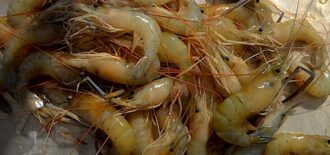Global demand for seafood is projected to increase by 70 percent in the next 30 years. Because harvests from capture fisheries are unlikely to meet that demand, some argue that a dramatic increase in aquaculture is needed to supply future aquatic food demands (USDA-NIFA). Although the Census of Aquaculture reported a $3 million increase in domestic, farm-level sales between 2005 and 2013, the United States remains a major importer of farm-raised seafood products, and one of the largest categories of imported aquaculture products is shrimp (USDA-ERS). Ohio freshwater prawn producer, Don Maloney, thinks producers in the Midwest can help meet this growing consumer demand by producing prawns locally.
Back in 2010, Maloney had a rough day at his day job. He had some land in Lancaster, Ohio, and decided to talk with Stan Smith with Ohio State University (OSU) Extension in Fairfield County about income opportunities. Freshwater prawn production was having some success in Ohio, and Maloney’s land fit the bill, so the two discussed the idea of an aquaculture business around prawns. Why prawns? According to Laura Tiu, an aquaculture specialist at OSU, freshwater prawn have great potential for diversification of Ohio farms due to their short growing season (June 1st- September 15th) that fits in well with other farm activities. They have lower labor requirements (20 minutes/day feeding and one long harvest day), and can use underutilized existing water resources (Tiu 2011). Additionally, giant freshwater prawns farmed in the U.S. in ponds receive a “Best Choice” recommendation from the Monterey Bay Aquarium’s Seafood Watch program.
Less than a year after his conversation with Smith, Maloney built his first pond with input from experts at OSU Piketon and the Ohio Aquaculture Association. Giving himself five years to see if he could make it work, he launched his new business, Don’s Prawns. Today, he sells unprocessed prawns to the public with a pondside harvest event, has a wholesale distributor, and sells at the Ohio Fish and Shrimp Festival. Maloney has four ponds, two of which are identical ponds that have served as a sort of laboratory for freshwater prawn research in Ohio; he has received three NCR-SARE Farmer Rancher grants since 2014 to conduct various experiments around making freshwater prawn production more sustainable.
At one point, Maloney and his crew were carrying 40-pound sacks to hand broadcast feed into the ponds, and Maloney wanted to improve efficiency. With a 2014 SARE grant, he developed a device to feed his prawns called the “shrimp shooter” using a leaf blower and an adjustable hopper to evenly broadcast feed across the ponds. They stocked two ponds to test the theory; they fed one pond of prawns by hand and the other using the mechanical device, and found that the device reduced labor and increased yields.
“For less than $300, this device increased yields by 17%, and based on this year stocking rates increased our gross dollars on one pond by $951.60,” said Maloney. “Based on our current stocking rates and our current operation (2 ponds) with an expected life cycle of seven years for the shrimp shooter, this $300 investment could increase gross dollars to a total of $13,022.40 over the seven year life cycle.”
Always striving for sustainability with his freshwater prawns, Maloney had read several studies documenting the benefits of adding artificial substrate to increase available surface areas (besides just the pond bottom) for prawns. He thought that if he added substrate to a pond, he could use the same amount of pond space and water, yet increase the size and yield of his prawns. With support from a 2015 SARE grant, Maloney staked plastic bird netting into one of his ponds (bird netting was used because it has a lower cost than orange construction fencing). Prawns are sold and categorized by size and weight; the pond with the substrate yielded 86% medium or large prawns, while the pond with no substrate yielded 79%. He said that adding substrate increased yields and profits. The substrate had a relatively low cost, yet increased yields and profits.
Maloney’s ponds have to supply enough oxygen for the prawns to survive, and the larger the prawns grow, the more oxygen they use. To meet this need, Maloney uses aerators to increase oxygen levels. He wanted to know if a low-cost unit, which consumes considerably less electricity, could handle the oxygen needs of one of his 1-acre ponds throughout the entire season. A third SARE grant in 2016 allowed Maloney to ascertain the viability and cost savings of using a low-energy aeration device compared to a commercial duty device to aerate his ponds.
“Based on the research from this grant, the recommendations for larger ponds (3/4 acres or more) would be not to deviate from the use of the commercial aerators, “ reported Maloney. “The output from the lower energy-consumption-air pump could not produce enough oxygen for the prawns to survive. I believe smaller ponds half acre or less, and stocking rate of five to seven thousand prawns could be feasible for the low energy-consumption pumps.”
Because he values the quality of life in his community, Maloney offers field tours, has a public harvest event, and brings FFA students from Fairfield Union High School to the farm to help during prawn harvest. In 2015, he received the Conservation Partner Award from the Fairfield Soil and Water Conservation District for outstanding efforts in promoting conservation programs. Right now, raising prawns is not his full-time job, but he’s optimistic about the growth of his business.
“We’ve got a niche market, and we sell out every year,” said Maloney, “It’s supplemental income for us for now, but every year we expand and get more efficient.”
